Played on Windows.
Also Available on Xbox One, and Nintendo Switch.
Announced for PlayStation 4.
Disclosure below (Review copy)
We are once again talking about a strategy game, and I’m a fan of strategy games. I love turn-based combat and a more tactical game. I’ve played these game for quite a while, whether they be RPGs like the old Might and Magic series, or Ultima, the XCOM Series, Into the Breach, or Nintendo’s versions, known in America as Advance Wars, as well as Fire Emblem to an extent. A new franchise in this genre has arrived, and its name is Wargroove. How does it compare to the other strategy games that have come before it?
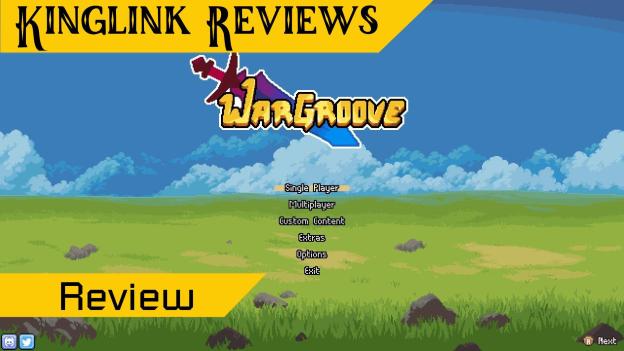
It’s clear that Wargroove is heavily influenced by both Advance Wars and Fire Emblem, and those names will come up multiple times in the review both from graphics to gameplay, however, one thing Wargroove has already improved upon is not being tied only to one platform. Wargroove is available on PC, Switch, Xbox One, with PlayStation 4 available this year most likely, though a specific date has yet to be given for that.
Graphics
I’d love to try to talk about Wargroove without heavily referencing Advance Wars, but as I said, the influence is so strong I do have to mention it upfront. This shouldn’t be seen as a negative though, but Wargroove really looks like it took heavy influence from Advance wars and that’s a good move.
Wargroove is a similar type of game, and Advance Wars art style is really well done. Though Wargroove does focus on more fantasy units, with knights on horseback, alchemists, archers and such, rather than mechanized units.
But if you aren’t familiar with Advance Wars, you’ll have a variety of units on your side, and enemy units of a different color. Every unit is well designed while retaining a sprite basis. On the world map, there are small images of your units, but when they attack each other you’ll get full-sized units who attack each other.
The units are really nicely detailed, and every unit is different. Each faction has their own units, and they all have a really nice look, whether it be the normal soldiers, the undead, forest people or desert people.
Though, this does have one issue stemming from it. While many units are similar, the different designs can be a little confusing. Three factions have units on a horse, one has them on buffalo type characters called a fluffalo. They’re functionally the same but they look different. Similarly, the undead knights are skeletons, which are functionally the same as the soldiers of the other factions. The desert people have a different looking Giant unit and so on. I probably can pick out five or six style choices that can be confusing.
Each class has their own name and icon for their units and there’s no tactical iconography used (like a knight emblem over the knight classes) which can be confusing and frustrating. After you fight each faction a few times it’ll eventually become more obvious but there are still moments where I’m not 100 percent sure of which unit at first glance until I look closer at them.
The visual level design in Wargroove is excellent, though. There’s a nice tactical map that appears but it also allows for more interesting designs where a few mountains together can form a range rather than a repeated design. Similarly, a forest can have a grove or a large mass and so on, and it produces a good looking game. Everything is clear and factions don’t change the look of the map either.
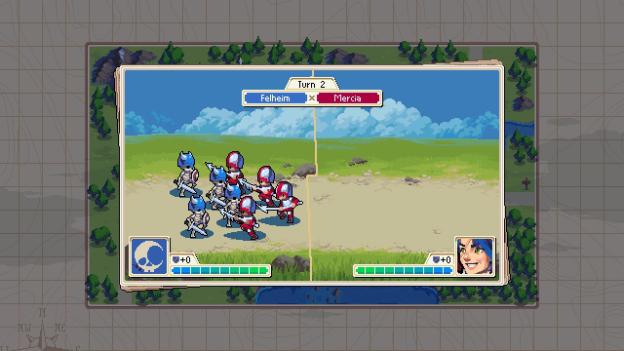
Combat looks great between well defined sprite characters. Though both of these are soldiers, which is the problem.
The combat in Wargroove also uses a really nice split screen where your units will walk over and attack the enemy directly (if not a ranged attack) and the enemy will have a turn to attack back at your units if possible. I really like the look of the combat to the point where I didn’t turn it off but only manually skipped it a few times because I still did enjoy watching my units damage the enemies and destroy them.
Though there is one other problem with Wargroove, and while I’ll talk more about what critical attacks are later, the fact that there’s no change in the battle animations when they are pulled off does sadden me. A simple sword spin or a fancy attack animation would have added an important indicator that the player had done something right or make the player notice they’d done more damage. The attacks are visually the same and I feel that something intangible is lost with that.
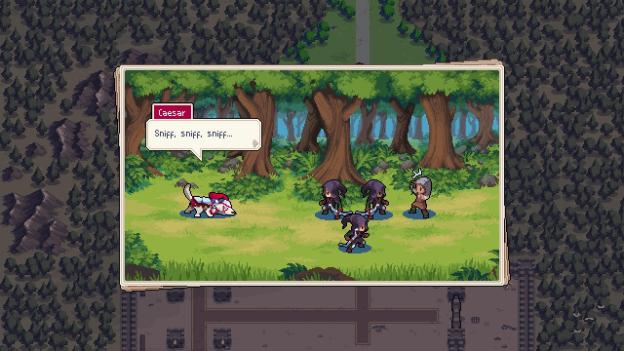
Introducing the bravest dog!
I do have to call out one character. The first faction has a queen and an advisor… but they also have a canine commander, and it’s really clear that the character is made to get people to talk about him. But damn, it works. Caeser is one of the cutest characters and, as a dog, it’s easy to like him. While he doesn’t play a huge role in the story, he’s still the most interesting and cutest character to look at in the game.
Story
Wargroove starts with an interesting opening. The first mission has the player playing as a character named Sigrid who enters a castle to assassinate a king. It seems that the story of Wargroove will have a huge effect on the missions and gameplay. Sadly this isn’t to be.
That prologue mission kicks off the story, but after that, the player quickly is engaged in mission after mission of fleeing from enemies or making their way through foreign lands with most missions just introduce a new force or a new enemy to be slain.
That’s not to say Wargroove’s story is particularly bad or missing. It’s neither and the story in the game is rather serviceable, but it’s only that. One problem is that the missions in the game can take an hour or more to play, where the story only really appears at the beginning and end. While there is one mission that has a wealth of story in the middle, that’s also the mission I was the least interested in replaying.
So really for a tactical game to have a great story it might be required to take a large amount away from the gameplay, Wargroove doesn’t really attempt this However, Wargroove does a great job at delivering an interesting narrative, even if it’s a little by the books for the most part. We have everything from fleeing Royalty, to a repeated misunderstanding which causes two armies to fight, to eventually a big bad weapon that appears at the end, and a surprising twist where an object appears to be something else.
Yes, Wargroove’s story is a bit by the books, but as I said, I would be amazed if they could integrate something deeper just due to the focus being on the longer tactical gameplay and trying to push the story would harm the flow of the game.
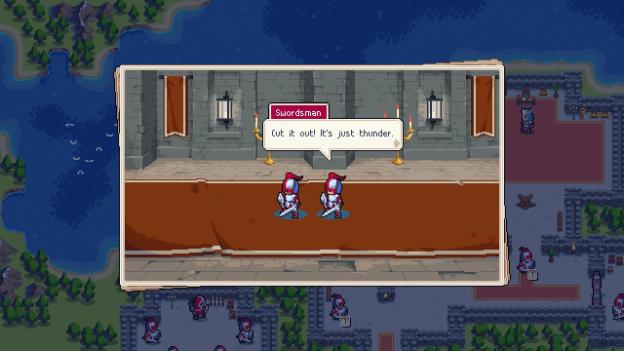
Cutscenes are played out on a small screen, but it works well.
The one thing the story does do is give the player opportunities to fight all the enemy commanders at least once, and play as almost all the characters in the game before the end. These allow the players to get a wealth of experience with the generals so after the story mode, the player can have a good idea of which general they prefer in future gameplay.
There are also interesting side missions for each character, and those have a lot more variety than the main story. We have everything from Caeser, the dog commander, trying to help villagers, to a king trying to discipline one of their generals and more. The side missions have interesting but short stories and they are entertaining as well and flesh out the characters a bit more.
I will admit to not seeing the full story. Sadly the final mission, the epilogue, requires 100 stars, with each mission giving up to 3 stars, this requires at least half of the game to be complete to reach it, as well as some portion of the puzzles, and arcade mode. While I haven’t reached this point yet, and am not sure if I will, I don’t believe it will change my general opinion on the story.
Gameplay
In a game like Wargroove, with sprite-based graphics, and a serviceable story, the gameplay was always going to be the key. Tactics based games are like chess. Players will stare at a board deciding their best move, whatever the graphical situation or story is, it needs to work in service of the tactical gameplay
As mentioned, this is a tactical game that’s very similar to Advance Wars. While much of the gameplay rules come from Advance Wars with a focus on commanders building units, the style has more in common with Fire Emblem, focusing on fantasy units, though not having permadeath, at least not in the same way.
Wargroove is focused on the 2d tile-based gameplay, and the core of the game is you are able to command your units, one at a time. You can make a move, and then immediately attack, capture a city if possible, reinforce your unit, or use a few special abilities. Much of the game is focusing on attacking or placing your units in advantageous positions where they can’t be attacked, or where the player can return more damage than they receive.
Wargroove is very tactical though. You’ll be focused on which units to move and which enemies to take out. There are a number of strengths and weaknesses as well. A soldier and dog unit is weak to a knight on horseback, who is weak to pikemen. Pikemen are about equal to the soldier but weak to dogs. Though this is hardly a complete list, it’s clear that there is a complex matrix of results between different units. With 20 units, there are a huge number of possible battles and thus outcomes.
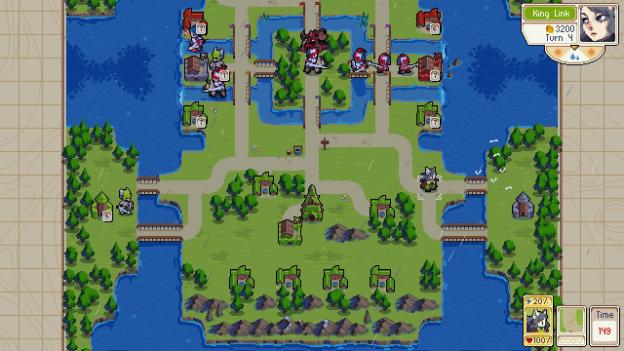
The map can look a bit simple but it’s obvious which team owns which location.
It’s important to note that there’s very little randomness, while the game might change the outcome slightly. An attack that should be a perfect kill (exactly how much life they have left) might leave an enemy with 1 percent of their life, and an attack that should leave an enemy alive can sometimes result in a kill. These situations are rare though, and for the most part, enemies are given the damage that is precalculated.
Wargroove units are more than just an attack table with every enemy type defined, each unit has an ability to have a critical attack, but again rather than a random chance, the critical attack is done by some game logic. Dogs can get critical attacks if the enemy is next to another canine unit. Pikemen do critical attacks if standing next to another pikeman. Swordsmen get critical attacks if standing next to a commander, and a knight on horseback gets critical attacks if they move 6 spaces to reach their target.
Each unit has different rules about their critical attack and mastering these will change strong units to near unstoppable forces to be reckoned with. At the same time, the commanders in the game do not have critical attacks but are the strongest units in the game and rarely require any type of assistance to dispatch enemies. Commanders get the additional ability to have a “Groove” allowing a special ability to be used once charged up.
The “Grooves” can range from healing all nearby units to allowing any neighboring units to take a second turn, to dash through a number of enemies causing damage. Each commander has their own “Groove” and each feels different.
While the “Grooves” do change up the style of gameplay, it is also the only difference between commanders or even factions. All the knights work the same, all the pikemen work the same. While this is probably optimal for most tactical games, it also means that there’s not much difference if you’re fighting the forest folk versus the desert people and I would have loved to see a different or unique experience for both.
There are three major modes of single-player gameplay in Wargroove. The story mode is a massive campaign of missions with over 30 missions, each with some story and a rather long mission. Most story missions took me close to an hour or more to complete. There are limits on which units are available per mission which allows the player to learn and figure out each unit individually.
After you beat the first act, arcade mode opens up. In this mode, you take a commander and attempt to fight your way through five random missions. Each commander has a set of five enemy commanders who will stand against them in the same order, but the maps that are used are randomized, though they are all mirror images, with an attempt to even the odds, with the second player getting an extra soldier unit of the appropriate faction.
Finally, after about half the story missions are defeated, puzzle mode unlocks. Puzzle mode gives the player a map with units already arranged on it. Players get a single turn to either kill the enemy commander or destroy the enemy HQ. There are usually only a couple of ways to win these maps, with near perfect moves required, but the single turn provided does make it an interesting challenge, though one for people who feel they have mastered most of the units.
The game also offers difficulty options as well so even if players aren’t skilled at Wargroove’s tactical gameplay, they can find a way to play and still have a decent challenge. There’s even an option to pretty much turn off all the challenge and allow players to see the story. I believe the difficulty options were in the original release of Wargroove, but there are difficulty presets that were added in patches post-launch and allow the player to customize the game to specific settings.

If you lower the difficulty, the game will lock out the stars you can earn, but still present an enjoyable experience.
There are a number of targets per story level awarding players more stars for higher skill, as well as similar star systems for the arcade mode. Lowering the difficulty limits the number of stars earned, as well as the rank, so completionists will have to tackle the default difficulty. The game does allow you to increase the difficulty beyond the original default but grants no award for doing so.
I ended up playing at a lower difficulty for about half of the game because a couple of missions are a bit harder than I was expecting. Sadly this can be a frustrating problem. I lost a single mission a couple of times in a row after what felt like an hour put into each attempt. One bad move can lose a mission and even a good strategy can fail but tends to fail after a large amount of time and losing so much invested time in a mission can really suck.
There is also a create a mission mode and a way to share the missions. At first, I wasn’t sure about this, but I think this will be the piece of Wargroove that the community will really focus on. I played a Doggy Dating sim involving Caeser. While it wasn’t amazing, it did show a lot of potentials, had multiple endings, different versions of the same missions with different friends, and unique cutscenes all in a brand new campaign.
I played a haunted house as well with a new story and cutscenes with its own rulesets. While I’m not sure how far the technology goes, I can only hope that the developer pushes the tools to allow fans to make their own experiences. Just using the in-game assets can do quite a bit, but allowing custom assets or at least new characters and models, could produce even better maps. While I don’t know how much I’ll play with the mode, this is definitely one that has unlimited potential for growth.
Finally, there’s multiplayer, with local and online multiplayer. While downloaded maps can only be used for local multiplayer or campaign mode, players can match online. You get similar maps to the Arcade mode, but facing a human opponent is a very different experience. While other players do take longer to make their moves, it’s a more challenging experience and one that competitive players will enjoy as long as it is active.
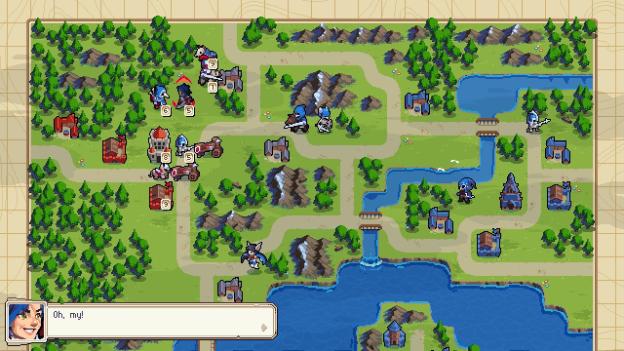
Story missions have less symmetrical maps, but also easier AI.
Another update from a patch was the addition of checkpoints in missions. Players are now able to save checkpoints while going through missions, and while it’s a great idea, it is a manual process currently, so it’s impossible to roll back a specific number of turns without saving a checkpoint at that point, and I believe only one checkpoint is allowed. In addition, checkpoints lockout S-ranks so they limit the abuse of the system.
There are a few more minor issues I have with Wargroove.
The controls can have some issues. I like to just target an enemy, and that works for most units, giving them a good move command to get into range. However, ranged units don’t work well with this system and it’s better to make a move and then attack the enemy as a command. Similarly, units that move and then attack try to move to the last place that was targeted.
Though I will also praise the fact that Wargroove allows the player to play with only the mouse, and doesn’t require a keyboard. I like playing with my controller and all its various buttons but being able to play the game with a two button mouse is really impressive, and shows the simplicity of the controls.
Wargroove doesn’t have a way to undo a mistake. Whether it be a battle result you didn’t expect or a misclick, the action is taken, and unless you have a checkpoint, there’s no way to return to the previous turn. I’m a huge fan of Into The Breach’s undo move, and I don’t exactly understand why Wargroove doesn’t offer a similar one turn or move rewind. Especially when a misclick or a bad move can ruin an hour long mission.
I find the enemy AI is easy to gimmick by saving up for higher tier units. Most of the time, the AI isn’t prepared for a Dragon barrage and only changes their tactics too late. Other players that I faced in Multiplayer clearly knew the right counters or was able to steamroll me before I could abuse the system, but for the AI it seems that there are usually a few units that they’re weak against.
Finally, there was one mission where I had to kill all the units, which worked well until I was down to a couple of underpowered units which ran from my units and just prolonged the missions a bit too much once their game was lost.
Conclusion
Overall though, I really like Wargroove, to the point where I am struggling with the score. Honestly, I think Wargroove is the perfect game for any fan of Advance war. If you like Advance Wars, pick this up on the system of your choice. But there are still a few issues with the game that I struggle with. The story is a bit weak, the different factions do look different for no real reason, and the game has a few minor flaws. Nothing huge, but enough that I don’t know if I can give this a perfect score. It’s on the border for me, but I’ve been trying to make the 5/5 mean something extremely special. While Wargroove is close, I think it falls a step short.
Wargroove earns a
4.5/5
It’s really close to perfect, and no one should see a 4.5 as a bad score for any game. This is still a heavy recommendation and I think anyone who enjoys any tactical game of any sort should check Wargroove out. This is an excellent game and so much fun. I started the game hoping for something to compare to Advance Wars and I believe I’ve found an even better game. Definitely check this one out.
Final thoughts: It is Advance Wars on the PC, it’s a Tile based XCOM game, it’s a strategy game with NO randomness. There are so many reasons to check out Wargroove, but above all else, it’s just really good.
Stats: 31.2 hours played 8/32 achievements earned.
Disclosure: I asked Chucklefish for a copy of this game. They provided me one, I appreciate the review copy however it did not affect my opinion on the game. I am disclosing though so you can best judge my review.
